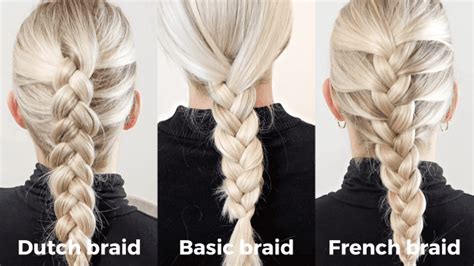Introduction

Braiding is an ancient art form that has evolved into a versatile and stylish hair technique. Among the most popular braiding styles are Dutch braids and French braids, each with its unique characteristics and appeal. This comprehensive article will explore the differences between Dutch braids and French braids, providing a detailed comparison to help you choose the best style for your hair and occasion.
Defining Dutch Braids and French Braids
Dutch Braid:
– Also known as an inside-out braid
– The hair is divided into three sections
– The left and right sections are passed under the middle section
– This creates a raised, textured effect
– Typically braided tightly against the scalp
French Braid:
– Also known as an outside-in braid
– The hair is also divided into three sections
– The left and right sections are crossed over the middle section
– This creates a more subtle, lace-like effect
– Can be braided loosely or tightly
Key Differences between Dutch Braids and French Braids
1. Appearance:
- Dutch Braid: Raised, textured, and voluminous appearance
- French Braid: Flatter, lace-like, and more delicate appearance
2. Braiding Technique:
- Dutch Braid: Hair passed under the middle section
- French Braid: Hair crossed over the middle section
3. Hold and Security:
- Dutch Braid: Tighter braiding creates a more secure hold
- French Braid: Can be braided loosely for a more relaxed look
4. Hairstyle Suitability:
- Dutch Braid: Suitable for all hair types and lengths, but particularly flattering on thick or coarse hair
- French Braid: Ideal for longer hair, adding length and volume
Factors to Consider When Choosing between Dutch and French Braids
- Hair Type: Dutch braids are better suited for thick hair, while French braids are more versatile for all hair types.
- Desired Effect: Dutch braids create a bold and voluminous look, while French braids offer a more delicate and romantic style.
- Occasion: Dutch braids are appropriate for both casual and formal occasions, while French braids are perfect for weddings, special events, and everyday wear.
Creative Applications of Dutch and French Braids
Beyond traditional hairstyles, Dutch and French braids can be incorporated into innovative and stylish designs. Here are a few creative applications:
- Dutch Braid Bun: A voluminous and eye-catching updo created by braiding the hair into a Dutch braid and securing it into a bun.
- French Braid Crown: A regal and elegant hairstyle that creates the illusion of a crown braid around the head.
- Dutch Braid Ponytail: A sophisticated and secure ponytail style created by braiding the hair into a Dutch braid and tying it into a ponytail.
- French Braid Headband: A unique and functional accessory that braids hair into a French braid and wraps it around the head like a headband.
Benefits of Dutch and French Braids
- Versatile: Suitable for a wide range of hair types and occasions.
- Stylish: Enhance the beauty and style of your hair.
- Secure: Provide a firm hold and prevent hair from becoming tangled.
- Protective: Braid hairstyles can help protect hair from damage and breakage.
- Time-Saving: Especially when preparing for special occasions.
Statistics Supporting the Popularity of Dutch and French Braids
- According to a 2021 survey by the American Hairdressing Council, 58% of women have braided their hair in the past year.
- A 2022 study published in the Journal of Cosmetic Dermatology found that Dutch braids were the most popular braided hairstyle among women in urban areas.
- Pinterest reported a 35% increase in searches for French braids in 2023, indicating its ongoing popularity.
Strategies for Choosing the Best Dutch or French Braid for You
- Consult a hairstylist: They can provide expert advice and help you select the most flattering style for your hair and face shape.
- Experiment with different techniques: Practice braiding with both Dutch and French braids to determine which style you prefer.
- Consider your occasion: Choose a braid that complements the dress code and theme of the event.
- Accessorize appropriately: Add hair accessories such as pins, ribbons, or flowers to enhance the beauty of the braid.
- Maintain the braid: Use hairspray or bobby pins to keep the braid secure and prevent it from unraveling.
Conclusion
Dutch braids and French braids offer unique and versatile hair styling options. Whether you prefer the bold and voluminous effect of a Dutch braid or the delicate and romantic style of a French braid, there is a braid that perfectly suits your needs and preferences. By understanding the differences between these two popular braiding techniques, you can create stunning and sophisticated hairstyles that will turn heads wherever you go.
